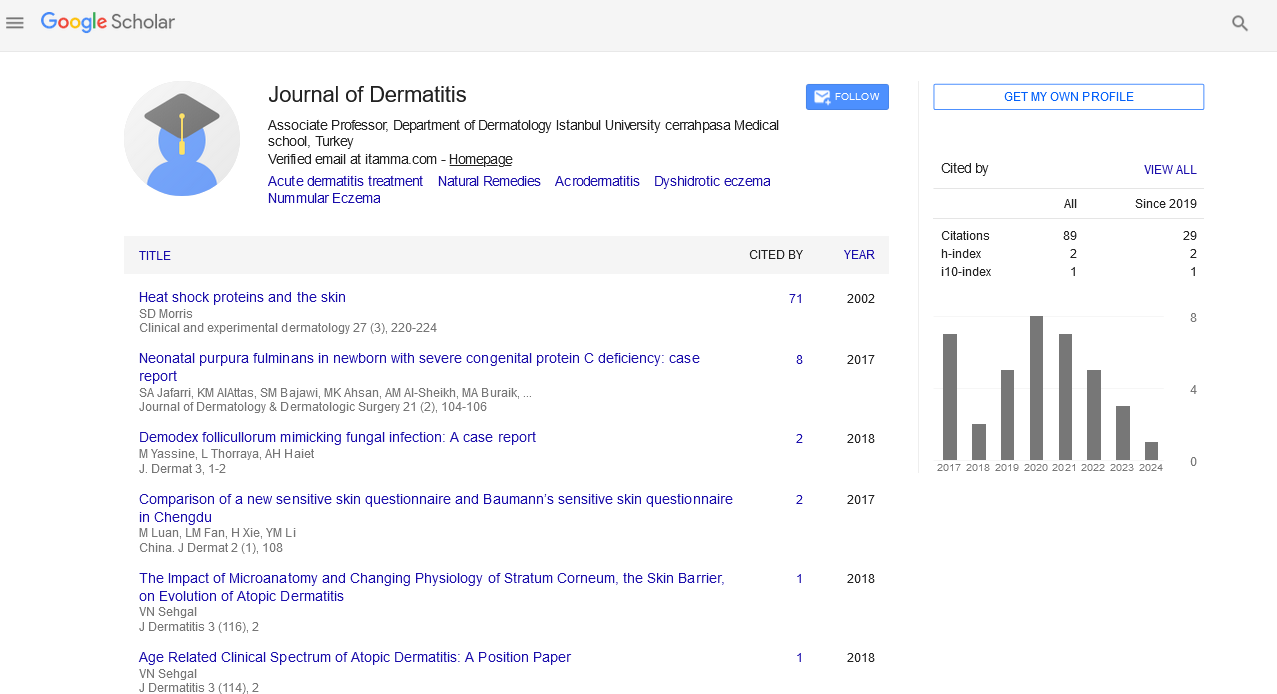Indexed In
- RefSeek
- Hamdard University
- EBSCO A-Z
- Euro Pub
- Google Scholar
Useful Links
Share This Page
Journal Flyer

Open Access Journals
- Agri and Aquaculture
- Biochemistry
- Bioinformatics & Systems Biology
- Business & Management
- Chemistry
- Clinical Sciences
- Engineering
- Food & Nutrition
- General Science
- Genetics & Molecular Biology
- Immunology & Microbiology
- Medical Sciences
- Neuroscience & Psychology
- Nursing & Health Care
- Pharmaceutical Sciences
Short Communication - (2022) Volume 7, Issue 3
Developmental Treatment Progress for Atopic Dermatitis
Zhou Paul*Received: 06-May-2022, Manuscript No. JOD-22-17066; Editor assigned: 10-May-2022, Pre QC No. JOD-22-17066(PQ); Reviewed: 23-May-2022, QC No. JOD-22-17066; Revised: 27-May-2022, Manuscript No. JOD-22-17066(R); Published: 06-Jun-2022, DOI: 10.35248/2329-6925.22.7.152
Abstract
Atopic Dermatitis (AD) is a chronic skin illness caused by complicated interactions between skin barrier abnormalities and a deregulated immune system, which is characterized by the activation of diverse T cell subsets at various phases of the disease. Until recently, the majority of patients were treated with moisturizers, topical steroids and topical calcineurin inhibitors, with systemic immunosuppressant are being recommended in seriously sick patients. New treatment techniques have been conceived and developed in recent years to target the many phases in the chain of molecular processes that rise to the AD phenotype. The focus of this short communication will be on current advancements in the treatment of Alzheimer's disease.
Keywords
Atopic Dermatitis; Alzheimer's disease; Immunosuppressant; Inflammatory pathways; Moisturizers
Description
Atopic Dermatitis (AD) is a skin disease that affects both children and adults [1]. While 70% of people with Alzheimer's disease outgrow it by the time they reach adolescence, 30% of cases last into adulthood [2]. An impaired cutaneous barrier and deregulated inflammation are hallmarks of Alzheimer's disease. Although the exact involvement of T-helper (Th)-2 cells in acute AD is uncertain, higher vulnerability to skin infections has been linked to inflammation. Mood issues, sleep disorders and work productivity are all more common in Alzheimer's sufferers. Around half of all youngsters with Alzheimer's disease say their sickness has a negative influence on their quality of life. Targetspecific biologics are being developed to intervene in the Th2 pathway or linked proximal events in Alzheimer's disease. Monoclonal antibodies against IgE, IL-4 receptor subunit alpha (IL-4R), IL-5, IL-13, IL-31 receptor A (IL31RA), IL-33 and TSLP have all been tested clinically for adult Alzheimer's disease so far [3]. Meanwhile, biologics that block the Th2 pathway are being evaluated in asthma and chronic rhinitis with nasal polyps, both of which have been linked to the Th2 pathway.
Targeted biologic medicines like dupilumab and tralokinumab target a specific immune route and its cytokines or receptors, whereas baricitinib uses small molecules to engage with various signal transduction pathways associated to different cytokine receptors and immunological pathways [4]. Despite these recent advances, the treatment arsenal remains restricted, and disease care is still based on a "one-size-fits-all" approach [5]. The high prevalence of Alzheimer's disease in children, the disease's extremely variable and unpredictable course and the field's limited arsenal of licensed medications with a sufficient benefit– risk ratio are all important obstacles [6]. To address this, a greater knowledge of the processes underlying epidermal barrier malfunction and the sequence of immunological responses underlying the chronic inflammatory reaction is required, which would ideally lead to improved long-term, disease-modifying care of this chronic condition.
Conclusion
Treatments for Alzheimer's disease have remained basically unchanged for a long time, with few notable advances. New topical medicines are being developed, but none have yet to equal the efficacy of mid-strength TCS. "Steroid phobias" and false allegations of "steroid addiction" have impeded that strategy, in part due to over-prescribing by doctors, but also due to emotion-based internet-generated worries. Clearly, stronger topical treatments with less adverse effects are still needed. Better understanding of immunological and inflammatory pathways has resulted in the most exciting advancements in AD therapy The development of dupilumab, for example, has resulted in a significant reduction in clinical severity with little side effects.
Many additional novel chemicals under development should continue to make significant progress in the treatment of this severe, common and complex disease.
REFERENCES
- Gandhi NA, Bennett BL, Graham NM, Pirozzi G, Stahl N, Yancopoulos GD. Targeting key proximal drivers of type 2 inflammation in disease. Nat Rev Drug Discov. 2016; 15(1):35-50.
[Cross ref] [Google Scholar] [PubMed]
- Gooderham MJ, Hong HC, Eshtiaghi P, Papp KA. Dupilumab: a review of its use in the treatment of atopic dermatitis. J Am Acad Dermatol. 2018; 78(3):S28-36.
[Cross ref] [Google Scholar] [PubMed]
- Kini SP, DeLong LK, Veledar E, McKenzie-Brown AM, Schaufele M, Chen SC. The impact of pruritus on quality of life: the skin equivalent of pain. Arch Dermatol.2011 .147(10):1153-6.
[Cross ref] [Google Scholar] [PubMed]
- Rerknimitr P, Otsuka A, Nakashima C, Kabashima K. The etiopathogenesis of atopic dermatitis: barrier disruption, immunological derangement, and pruritus. Inflamm Regen. 2017.37(1):1-5.
[Cross ref] [Google Scholar] [PubMed]
- Schwartz DM, Kanno Y, Villarino A, Ward M, Gadina M, O'Shea JJ. JAK inhibition as a therapeutic strategy for immune and inflammatory diseases. Nat Rev Drug Discov. 2017; 16(12):843-62.
[Cross ref] [Google Scholar] [PubMed]
- Wu J, Guttman-Yassky E. Efficacy of biologics in atopic dermatitis. Expert Opin Biol Ther. 2020; 20(5):525-38.
[Cross ref] [Google Scholar] [PubMed]
Citation: Paul Z (2022) Developmental Treatment Progress for Atopic Dermatitis. J Dermatitis.7:152.
Copyright: © 2022 Paul Z. This is an open access article distributed under the terms of the Creative Commons Attribution License, which permits unrestricted use, distribution, and reproduction in any medium, provided the original author and source are credited.

